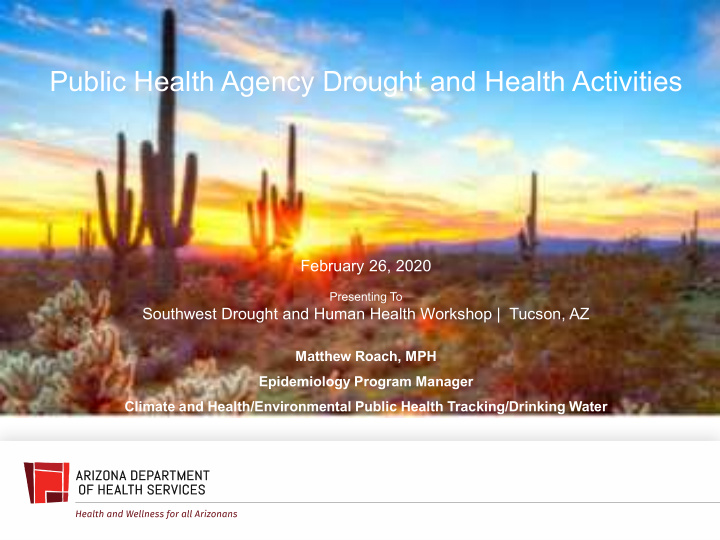



Public Health Agency Drought and Health Activities February 26, 2020 Presenting To Southwest Drought and Human Health Workshop | Tucson, AZ Matthew Roach, MPH Epidemiology Program Manager Climate and Health/Environmental Public Health Tracking/Drinking Water
Heat Deaths in Arizona Heat-Related Deaths 300 250 200 150 100 50 0 2008 2009 2010 2011 2012 2013 2014 2015 2016 2017 2018 Heat-Related Deaths
2018 Arizona Heat Deaths Summary • 75% were Arizona residents • 58% were over 55 years old • 79% were Male • Most Deaths occurred in (Maricopa, Pima, Mohave, and Pinal) • 98% of cases occurred from May - September
Heat Illness Emergency Department Visits in Arizona Emergency Department Visits 3500 3000 2500 2000 1500 1000 500 0 2015 2016 2017 2018 Emergency Department Visits
2018 Arizona Heat Illness Summary • 88% were Arizona residents • 45% were Young Adults 20-44 • 68% were Male • Most cases occurred in (Maricopa, Pima, Pinal, and Yuma) • 93% of cases occurred from May - September
Health Department Programs Working on Drought Issues Environmental Climate and Public Health Health Tracking Well Water Food Safety Safety Emergency Preparedness
Environmental Public Health Tracking azdhs.gov/epht
CDC National Tracking Website Data Explorer https://ephtracking.cdc.gov/
Climate Data Environmental Health Outcomes – Drought – Asthma – Extreme Hospitalizations Precipitation – Cold Stress – Flood Vulnerability Hospitalizations – Temperature – Heat – Heat Vulnerability Hospitalizations – Wildfires – Heat Deaths – Hazard Losses – Air Quality
Number of Extreme Heat Days
Future Number of Days over 100 Degrees
Number of Acres Burned by Wildfires
Number of Months of Extreme Drought Per Year
Cost of Property Damage from Natural Hazards
Percent of Days Annually Above the Air Quality Standard for PM10
Number of Heat Illness Emergency Department Visits
Tribal Lands on the Data Explorer
Quick Reports Tool
Participate in the 2020 State Heat Planning Meeting (April 13,2020)
Climate and Health
CDC Climate Ready States & Cities Initiative Grantees
CDC Climate-Ready States & Cities Initiative Grantees
ADHS Reports
Drivers of Health Risks Associated with Drought • Climate – Atmospheric composition and changes • Individual – Behavior, age, health status, time lived in AZ, pre- existing medical conditions • Societal – Population size, population demographics, interventions/policy efforts
Drought Hazard Risk Categories • <5 inches * • 5-10 inches * • 10-15 inches * • 15-20 inches • >20 inches * High drought exposure
Precipitation by County
Social Vulnerability • Poverty • Over 65 years of age • Living alone • Low education
Arizona Vulnerability Analysis Percent of County Population By Vulnerability Class
Social Vulnerability and Drought
DUST STORMS
Motor Vehicle Accidents • 2018 – 150 motor vehicle crashes from blowing sand, soil, dirt – 0 fatalities – 86 injured
Dust Storms
61% of people live in places with moderate dust storm exposure
WILDFIRES
Hotspots for wildfire activity: • Northern Mohave County • Northern Coconino County • Southern Pima County and Santa Cruz County • A large section of central and eastern Arizona
Vulnerable Populations and Projecting the Disease Burden
Well Water Safety
Food Safety
Health Mental Health Air Pollution Zoonotic Diseases Nutrition and Hygiene
Emergency Preparedness
It Takes A Village…Multi-Organization Effort
Drought
CDC Resources on Drought https://www.cdc.gov/nceh/drought/ default.htm
CDC Drought Communication Toolkit https://www.cdc.gov/nceh/drought/toolkit/default .htm
INTERVENTIONS
Dust Storm • Forecasting and warning systems • Public Service Announcements • Pull Aside Stay Alive – Turn off car lights
Wildfire Preparedness • Evacuation Procedures • Air Filtration • Forecasting and warning systems • Public Service Announcements
(Valley Fever)
ADHS Valley Fever Surveillance
Best Practices • Multi-organizational approach • Collaborate with local Environmental Public Health Tracking Programs to showcase data on health department interactive dashboards • Collaborate with local BRACE Programs to get drought hazard information into climate adaptation plans • Discuss drought interaction with environmental hazards such as wildfires
Gaps • What are the health costs of drought impacts? • Is there drought and health data missing from tribal lands?
Conclusions • Consider applying the BRACE framework to prioritize environmental hazards • Consider the following health effects related to drought: – mental health, physical injury, and respiratory exacerbation • Consider the following environmental effects related to drought: – dust storms and wildfires
Acknowledgements & Disclosures • Many thanks to the CDC Climate Ready States and Cities Initiative, the Arizona State University BRACE Team, and the University of Arizona BRACE Team for support on this project. • This presentation was supported by Cooperative Agreement Number 5NUE1EH001318-03-00 and 5 NUE1EH001339-02-00, funded by the Centers for Disease Control and Prevention Climate Ready States and Cities Initiative and Environmental Public Health Tracking Network. • Disclosure: Contents of this presentation are solely the responsibility of the authors and do not necessarily represent the official views of the Centers for Disease Control and Prevention of the U.S. Department of Health and Human Services.
Thank You for Attending!
THANK YOU Matthew Roach, MPH | Epidemiology Program Manager Matthew.Roach@azdhs.gov | 602-364-3673 azhealth.gov @azdhs facebook.com/azdhs
Recommend
More recommend